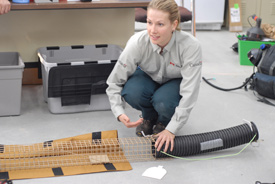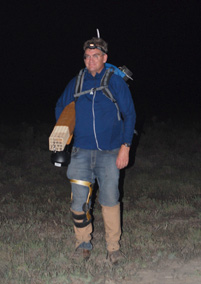A few years ago I saw the end of Return of the Prairie Bandit on CBC's The Nature of Things and said to myself: THAT'S what I want to do to mark my 60th birthday: track the black-footed ferret in Grasslands National Park.
And so - Willem and I did exactly that this past week (August 14 and 15), as part of a team of some 60 or so other trackers. As Willem remarked: it's like being allowed backstage in a fascinating drama production.
Grasslands National Park itself is a spectacular sweep of mixed-grass prairie edging the US border in the middle of Southern Saskatchewan (visit the Park website at Grasslands). The first picture is taken from our accommodations (spitting distance from the Park) , the second is the Eco Tour Road, standard point of entry into the land.
I'm not sure how one falls in love with a landscape, but I know it's possible, for that's what happened when I visited for two nights in October 2011 - I fell in love with the geography of Grasslands. A few pictures of the landscape from October 2011:
In this vast landscape are - hopefully - some dozen or so ferrets.
A few ferret facts: The black-footed ferret is a species unique to the (mixed) grasslands prairie of the North American midwest. It was extirpated from its prairie home in Canada and thought to be extinct since early in the 20th century. In 1981 the chance finding of a ferret in Colorado led to discovering18 more. These became the core of a captive breeding program. Currently there are some 300 ferrets still in breeding captivity, and around 700 in the wild. A few of these wild-again ferrets live in Grasslands National Park.
They're awfully cute - the image below from US Fish and Wildlife Service Endangered Species:

A ferret's main diet is the prairie dog (in Grasslands the black-tailed, in other grasslands biomes the white). A single ferret typically eats around 100 prairie dogs a year, a nursing female with kits more than 400. It is logical that the systematic destruction of the prairie dog through habitat loss (agriculture) and targeted killing (drowning, application of government-issued strychnine, etc. etc. etc.), resulted in the demise of the ferret.
Tracking those remaining few ferrets is no easy matter. They are nocturnal, with greatest activity at dusk and dawn. A single ferret might have a territory of 100-150 acres of prairie dog territory (aka colonies). So tracking needs to happen at night, over a large area, a number of times - the Parks could not possibly afford the 700 people hours that managed to locate Grasslands' twelve, possibly thirteen ferrets last year. The answer: the volunteer tracker program.
First there is excellent training (this image from GNP website) showing Parks employee extraordinaire Ashley Wruth demonstrating the ferret trap and the "ferret purse" used for transporting any trapped ferrets:

But before ferrets can be trapped (and released, of course!), they must be spotted. The program is a total of ten nights, broken into periods of 2, 3, or 5 nights, with six-hour shifts spotlighting from either 8:15 p.m. to 2:15 a.m. or 12:15 a.m. to 6:15 a.m.. For their shift, volunteer trackers set out with 2-way radios, GPS units, spotlights, scanners, traps, "ferret purses," bug spray, and personal supplies to walk loops in designated colony areas. Below a fully-equipped tracker setting out (taken from the GNP website) - note the brown snake gaiters:

Here are Willem and I setting out the first night (packs still in the truck, which Willem got to drive), in the second picture with program coordinatorAshley Wruth in front of "our" territory, the Larson colony:
It's an extraordinary experience. Walking from GPS point to GPS point as darkness falls, scanning with the spotlight to locate the give-away emerald "eye-shine" of the ferret, walking in darkness and stillness for around five hours, taking breaks and looking straight up at the Milky Way and meteor showers in one of Canada's Dark Sky Preserves while coyotes howl and some lightning flashes in the distance - one gains perspective on one's own tiny little place in the eons of earth time below and the infinite universe above.
The prairies show themselves as unexpectedly diverse, when experienced so close-up for such a length of time. What looks like a fairly homogeneous landscape has many small sub-landscapes in it - grasses, marshes, gullies, tussocks, semi-arid spots. In the photo below, the "bumps" are the hillocks of dirt excavated by prairie dogs, the cleft in the land the Frenchman River valley:
At night there are snakes (we wore snake gaiters), frogs, weasels, deer, foxes, coyotes, bats, bison (which no one encountered during our watch) - and of course bugs, millions and billions and trillions of bugs. The bugs vary during the night - the subway screech of mosquitoes gives way to the delicate flutter of hundreds of white moths which all disappear when the temperature drops. One bat accompanied us on our rounds, perhaps because the spotlight attracted a larger concentration of bugs. We were excited to spot two weasels (first thinking they were ferrets), but they disappeared in the underbrush; we also saw deer. Other trackers saw coyotes, a swift fox. There were some beautiful Northern Lights.
It was a treat to come home at 3:30 a.m., tired and somewhat sore, to the lovely accommodations (two bedroom apartment, fully equipped) at The Crossing Resort, located on the edge of the Park. A glimpse of the apartment's interior shows us having dinner with our Regina friend Bruce:
We did not see any ferrets. No one on our watch did. And yet it was a wonderful experience. My getting-older body did better than I expected, despite taking two tumbles on the uneven terrain. And it's hard to describe the serenity I felt, lying on my back on the prairie at night, unafraid, situated between land and sky and feeling connected to both. I will go back, one way or another.








No comments:
Post a Comment